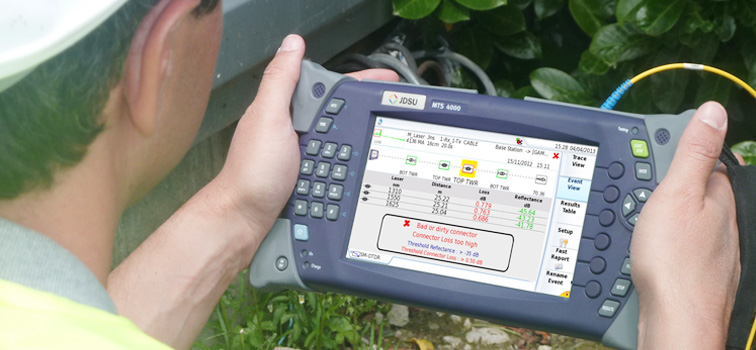Passive
optical network (PON) is a cost-effective way to deliver high-bandwidth
broadband services to users and widely deployed all over the world.
FTTH uses PON technology and provides high bandwidth from the central
office (CO) to subscribers. FTTH PON system achieves network reliability
and makes network testing, monitoring and measuring easier. This
article will tell about FTTH PON testing from the four aspects below.
Connector Inspection
Connector
inspection/cleaning plays an important role in network installation and
maintenance. Typically an optical microscope is used for connector
inspection. To prevent accidental eye damage when inspecting fibers
potentially carrying live traffic, a video microscope images the
connector end-face and displays the magnified image on a handheld
display. In this way, the dirt, debris or damage on the connector could
be easily detected. According to the study by NTT-Advanced Technology,
connector contamination and damage are the key reason for poor optical
network performance.
Insertion Loss Test
In
telecommunications, the term “insertion loss” expressed in dB, refers
to the loss of signal power resulting from the insertion of a device in a
transmission line or in an optical fiber. An insertion loss test
measures the end-to-end loss of the installed link by injecting light
with a known power level and wavelength at one end, and then measures
the received power level output from the other end. The measured
difference between the transmitted and received power levels exactly
indicates the very optical loss through the network. In some occasions,
insertion loss is allowed and considered acceptable when the measured
loss level is lower than the budget loss level.
Optical Return Loss Test
In
telecommunications, return loss expressed in dB, means the loss of
power in the signal returned or reflected by a discontinuity in a
transmission line which can be a mismatch with the terminating load or
with a device inserted in the line. The optical return loss test injects
light with known wavelength and power level into one end and measures
the power level returned to that same end. Then the return loss is the
difference between the injected power level and the measured return
level. When the return loss is higher than the budgeted return loss
target, it is considered acceptable.
Typically
insertion loss test and return loss test are performed by using
wavelengths at those which will be used during network operation. For
FTTH PON system, 1310nm wavelength is used in the upstream direction,
while 1490nm and 1550nm wavelengths are used in the downstream
direction. So it is essential to have insertion and return loss testing
at 1310nm, 1490nm and 1550nm wavelengths. The optical network is
considered ready for activation when the insertion loss and return loss
measured at each wavelength are within the budgeted levels for the link.
However, in some cases, the network operator uses an optical time
domain reflectometry (OTDR) as the following picture shows for more fully documented network.
Optical Time Domain Reflectometry (OTDR)
OTDR
scans a fiber from one end to measure the length, loss and optical
return loss of an optical network. And it also locates and measures
reflective or non-reflective events in the network caused by splices,
connectors, splitters, faults, etc. OTDR operates like a radar by
injecting narrow pulses of light into the fiber under test. As each
pulse travels down the fiber, imperfections in the fiber scatter some of
the light, with some of this Rayleigh-scattered light being guided back
up the fiber.
Summary
From
the above description, four tests are commonly used to verify optical
links. Proper testing is critical for FTTH PON installing, activating
and maintaining, because excess loss or reflectance can result in poor
network performance if not detected and corrected. And over time,
transmission errors will occur before the need for any maintenance
activity.
Article source: www.fiberopticshare.com/how-much-do-you-know-about-ftth-pon-testing.html
Article source: www.fiberopticshare.com/how-much-do-you-know-about-ftth-pon-testing.html

没有评论:
发表评论